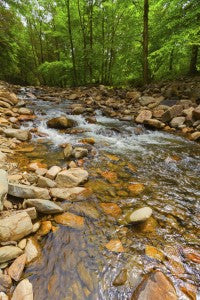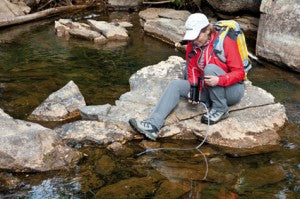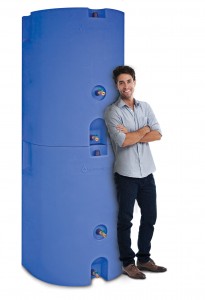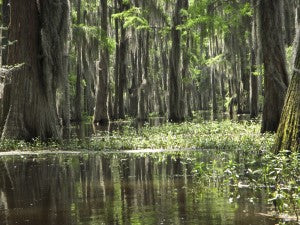
If you’re out in the wild and see a clear stream or river, you might think you've found safe drinking water. After all, you can see to the bottom and there aren’t any weird-looking floaties. Before you take even a sip from that water source, you may want to treat it. Actually, let me rephrase that. You will want to treat it. Drinking water that hasn’t been filtered or purified can have disastrous results. Diarrhea, fatigue, and vomiting are just a few of the negative side effects of drinking untreated water, not to mention diseases such as cholera that can crop up from it. So yeah, you’ll want to treat the water. When it comes to securing clean, safe drinking water for you and your family, knowing the differences between filtering and purifying, as well as how and where to store said water, can help you make an educated decision as to which type of tool you will need. And that’s exactly what we’re going to talk about today. Filters [caption id="attachment_18710" align="alignright" width="300"] Get safe drinking water with Katadyn's Hiker Pro water filter[/caption] Water filters are like colanders. After you’ve finished boiling your pasta or pot stickers (or whatever it is you fancy for dinner), you dump it all into your colander. The water drains through the little holes in the strainer, while your food is unable to fit through, so it just stays behind. Water filters are the same way. They physically obstruct impurities in the water by not allowing them to pass through the filter. Filters are effective in eliminating bacteria, protozoa, and cysts, all of which can cause diseases. They may not, however filter out smaller floaties such as viruses. One of the nice things about filters is that many are small and portable, so you can take them with you camping or hiking, or even to just keep in your emergency kit. Filters like the Katadyn Hiker Pro and the Katadyn Combi are favorites of many hikers, campers, and preppers alike. Purifiers While filters get rid of many harmful substances, purifiers make water safe from the remaining impurities such as bacteria and viruses. Usually this is done by using chlorine or iodine. Purifiers will not, however, take out sediment and other larger, harmful things, such as heavy metals. These purification tablets are a popular choice among hikers, campers, preppers, and travelers, as they are small, easy to carry, and can be used to treat water wherever you are, especially during an emergency. Purification can be used after filtering your water for extra security in your water's safety. Storing Water Another option to ensure you have safe drinking water is to have a long-term water storage. Of course, that water needs to be clean when it was packaged. There are a few options to go about storing water. The first is to get pre-packaged water. You know it’s clean and it will last quite some time. It’s also easy to grab on your way out the door in the event of an emergency. Another option is the do-it-yourself method. This is the favored way of many people. If you decided on the do-it-yourself method, make sure you use good, food-grade plastic, such as pop bottles. Don’t use containers that once housed milk or juice, as the proteins and sugars can spoil your water. [caption id="attachment_18713" align="alignright" width="205"]
Get safe drinking water with Katadyn's Hiker Pro water filter[/caption] Water filters are like colanders. After you’ve finished boiling your pasta or pot stickers (or whatever it is you fancy for dinner), you dump it all into your colander. The water drains through the little holes in the strainer, while your food is unable to fit through, so it just stays behind. Water filters are the same way. They physically obstruct impurities in the water by not allowing them to pass through the filter. Filters are effective in eliminating bacteria, protozoa, and cysts, all of which can cause diseases. They may not, however filter out smaller floaties such as viruses. One of the nice things about filters is that many are small and portable, so you can take them with you camping or hiking, or even to just keep in your emergency kit. Filters like the Katadyn Hiker Pro and the Katadyn Combi are favorites of many hikers, campers, and preppers alike. Purifiers While filters get rid of many harmful substances, purifiers make water safe from the remaining impurities such as bacteria and viruses. Usually this is done by using chlorine or iodine. Purifiers will not, however, take out sediment and other larger, harmful things, such as heavy metals. These purification tablets are a popular choice among hikers, campers, preppers, and travelers, as they are small, easy to carry, and can be used to treat water wherever you are, especially during an emergency. Purification can be used after filtering your water for extra security in your water's safety. Storing Water Another option to ensure you have safe drinking water is to have a long-term water storage. Of course, that water needs to be clean when it was packaged. There are a few options to go about storing water. The first is to get pre-packaged water. You know it’s clean and it will last quite some time. It’s also easy to grab on your way out the door in the event of an emergency. Another option is the do-it-yourself method. This is the favored way of many people. If you decided on the do-it-yourself method, make sure you use good, food-grade plastic, such as pop bottles. Don’t use containers that once housed milk or juice, as the proteins and sugars can spoil your water. [caption id="attachment_18713" align="alignright" width="205"] The 320-gallon water reserve will keep you well-watered with safe drinking water[/caption] Purchasing water containers is a good option, because the quality will be good, and many (if not most) are blue in color, which helps prevent the sun from penetrating your water and helping little organisms grow. As some examples of these kinds of water containers, we carry 5-gallon jugs, 15-gallon, 30-gallon, and 55-gallon water barrels, and even a 160-gallon water reserve (the 160-gallon water reserves stack, by the way, to allow you to have a 320-gallon ultimate water reserve. That’ll keep you going for a while!). While you may not have room for a 320-gallon behemoth, the smaller barrels and containers are great options to keep in your basement, garage, or wherever it is you store water. Just remember: keep them out of direct sunlight, and the cooler the storage temperature, the better! When storing water that came from your faucet, it should be swapped out every six months. However, in order to make sure the tap water you’ve stored for a year or more is still safe to drink, Zane Satterfield (engineer scientist at West Virginia University), suggests adding four drops of plain, unscented bleach (per gallon of water) to your water container, let sit for 30 minutes, and you’ll be good to go. Standing & Stagnant Water vs. Running Water [caption id="attachment_18708" align="alignright" width="300"]
The 320-gallon water reserve will keep you well-watered with safe drinking water[/caption] Purchasing water containers is a good option, because the quality will be good, and many (if not most) are blue in color, which helps prevent the sun from penetrating your water and helping little organisms grow. As some examples of these kinds of water containers, we carry 5-gallon jugs, 15-gallon, 30-gallon, and 55-gallon water barrels, and even a 160-gallon water reserve (the 160-gallon water reserves stack, by the way, to allow you to have a 320-gallon ultimate water reserve. That’ll keep you going for a while!). While you may not have room for a 320-gallon behemoth, the smaller barrels and containers are great options to keep in your basement, garage, or wherever it is you store water. Just remember: keep them out of direct sunlight, and the cooler the storage temperature, the better! When storing water that came from your faucet, it should be swapped out every six months. However, in order to make sure the tap water you’ve stored for a year or more is still safe to drink, Zane Satterfield (engineer scientist at West Virginia University), suggests adding four drops of plain, unscented bleach (per gallon of water) to your water container, let sit for 30 minutes, and you’ll be good to go. Standing & Stagnant Water vs. Running Water [caption id="attachment_18708" align="alignright" width="300"] Standing water is a breeding ground for microorganisms.[/caption] If you Replace yourself hunting for water in the wild, running water is practically always a better option than standing or stagnant water. That’s because water that isn’t moving becomes a breeding ground for harmful microbes that can make us incredibly sick – or worse. Running water, such as in rivers and streams, make it more difficult for such dangerous life to settle down and thrive. Of course, that doesn’t necessarily make running water safe to drink, either. There are still harmful microbes floating around in rivers and creeks and streams that you’ll want to filter out. As you can see, there are plenty of options for securing safe, clean drinking water. Choose the option that’s best for you, but don’t forget to have a backup plan, just in case. After all, if you have a 55-gallon water barrel and are forced to evacuate, you’ll be happy you have your handy-dandy Katadyn Hiker water filter (or other water filter that suits you better). On the other hand, your favorite water filter won’t be much good in case of a drought, but your 320-gallon water reserve will most certainly come in handy. And of course, a combination of resources is always a great option. How do you acquire clean, safe drinking water? Let us know in the comments below!
Standing water is a breeding ground for microorganisms.[/caption] If you Replace yourself hunting for water in the wild, running water is practically always a better option than standing or stagnant water. That’s because water that isn’t moving becomes a breeding ground for harmful microbes that can make us incredibly sick – or worse. Running water, such as in rivers and streams, make it more difficult for such dangerous life to settle down and thrive. Of course, that doesn’t necessarily make running water safe to drink, either. There are still harmful microbes floating around in rivers and creeks and streams that you’ll want to filter out. As you can see, there are plenty of options for securing safe, clean drinking water. Choose the option that’s best for you, but don’t forget to have a backup plan, just in case. After all, if you have a 55-gallon water barrel and are forced to evacuate, you’ll be happy you have your handy-dandy Katadyn Hiker water filter (or other water filter that suits you better). On the other hand, your favorite water filter won’t be much good in case of a drought, but your 320-gallon water reserve will most certainly come in handy. And of course, a combination of resources is always a great option. How do you acquire clean, safe drinking water? Let us know in the comments below! 

59 comments
Johnny McCarron
Ah, thank you for your guide to have safe drinking water. Lately, I’ve been concerned about the tap water in my home. With that in mind, I’d like to try installing a water filter to improve the water quality. http://www.fletcherpumps.com.au/water-filtration
TW
So many ways to have water supply interrupted, which makes water filters a must.
Lisa Ogle
All I have is bottled water foe an emergency I am looking into affordable filter options.
Nathanael B
I’d love to have a filter, since it would remove everything, not just zap it, but when I’m backpacking I currently us UV treatment for water, and I find it quite convenient.
Morana Revel
Water is the one item I need better preparedness for.
Peter Mogish
Have some “dry” bleach if water is not clear, and Chlorine Dioxide chemicals if I suspect Virus in the water.
Stephanie Bonck
I am near lakes that are known for being dirty. I like to be prepared.
CathyR
I have a month’s worth of gallon jugs of water, which I treated with 1/8 tsp of bleach. I also have water purification tablets, coffee filters, a LifeStraw and a hiking filter (forgot the name). I haven’t tried any except the gallon jugs, when the power occasionally goes out. I have a rain barrel but it wouldn’t be good for drinking.
kevinsjenn
Thanks for the info! Living in the desert, we are working hard to get our water storage at a level we are comfortable with. We have been buying gallons at the store until we can afford a larger storage system.
Mary Beth Elderton
Hubz and I have just settled into a small home with a basement so we now have a little bit of space—-yay! But we are in an older part of a city, so many things can go wrong. So far, I have a couple of cases of bottled water and a couple of filter pitchers. My goal is to both add more capacity in those ways and to add a method for purifying water.
Dominique
Rotating the three gal per day per person and/or boiling/filtering. Those 100’s of miles of backpacking taught me a thing or two about how to do this many many years ago. I think a filter is a needed option for prep though.
Corey Olomon
You should always have multiple sources, such as bottle water, filter and purification pills.
Jan afPetersens
water filtration is the big issue in general and saltwater is hard to do without destilling
Brenda
I am embarrassed to say we have had 2, 55 gallon drums for over 10 years but have not filled them with water, partly because we keep hearing conflicting information on how to properly fill them. Also we found an unused PUR Explorer Microbiological water purifier at a garage sale for a couple dollars (price tag says $130!) But we need to figure out if it is still OK to use (price tag dated 1997).
laura mccubbin
bleach, purification tablets,charcoal, filter bottle,sawyer mini
Sarah D.
We have a Berkey and use that to filter water.
Amy J
Wow. I am learning so much. I prepped for Y2K but never went beyond that for disaster preparedness. Now given all of the craziness in the world, I’ve already set up 2 out of 4 bug-out backpacks with 72 hours of food, water, and emergency supplies. Once I finish those, I need to make 2 for our pets and continue stocking the basement for possible lock-down emergencies in the home.
Mindy Watkins
We take our kids into the mountains almost every weekend during the summer. We have an emergency bag with is but we don’t have a water purifier. The Katadyn series looks amazing. Easy, portable, and capable of getting us that life saving water. Our Emergency Essentials food won’t be much help without water.
Jim Wallen
Excellent company to do business with. We love the blog article on water, it open the doors to new ideas and we learned a few things we didn’t know.
Deeme
Back ups to back ups are always a good idea!
Tim mc
Just learning. This is helpful. Thanks
Cassie
I have a spring fed pond that I plan to use if power fails long term.
Cyndi
Thinking ahead to multiple options/sources is a good tip! Don’t rely on one thing – have your back up, a back up to that back up and a back up to that back up!
Yvette Rose
Always have back ups for water storage and transport (if needed), because you never know.
Ficjunkie
I’m working on building up a supply of 5-gallon storage tanks.
Ron
I used Katadyn filters back 30 years ago or so backpacking, and they rock. They know what clean water is about.
John in MT
Lehmans.com has a “well bucket” that fits into a suburban well-head and can retreve 2 gallons of water at a time without electricity. Not living near a flood plain and with a lot of head in my well my only worries on water availability are earthquake crushing my well casing (not at all likely) and long term loss of power.
Patrick Harrison
Interesting. I like my Sawyer Mini, but may have to give this a try.
krisocrat
First clean the container with bleach then rinse it out very thoroughly. Then add the EPA’s recommend amount of bleach for 55 gallons before filling the tank with water. The tank should be away from sunlight. If you have free-chlorine checker, then start out with less than the recommend amount of bleach and work up to correct amount.
https://www.epa.gov/ground-water-and-drinking-water/emergency-disinfection-drinking-water
Erin Gogolek
I can water in jars to fill my canner with each run.
J Zabes
Currently use iodine tablets.
Luke
Hi Judy,
You can use regular tap water and add a water preserver. That should keep the water safe for 5 years.
Sarah
Our city provides us with clean drinking water, and we are able to store extra.
Rod Z.
Since water is the primary substance needed for survival, scrimping on filtration, treatment, and storage is penny wise and pound foolish. I have carried a Katadyn Pocket Filter in my personal Get Back Home bag for a number of years. I understand the use of the “Straw” type filters, but they make it difficult if not impossible to get water for cooking or hygienic needs. The Katadyn units allow you to store water in another container for other uses. Also if you look at the gallons per filter for these portable filters the Katadyn is the most economical by far. If you have larger filtering requirements Katadyn makes a line of marine filters too. I have no financial stake in any of these companies. I am just a very satisfied customer.
Tom
I have four 55gal drums that will be cleaned and sealed soon. Got them for y2k and used them many times when it was necessary.
Gregory Dewees
Great info.. Could really use a good portable filter.
Yvette Rose
I like the 320 gallon water storage units. Would love to have at least one in case a hurricane knocks out the water service here. The hiking filter is just too handy!
Carol Ann
I have had a Berkey water filter system for 5 years. I only wish I had purchased it sooner as I LOVE it! I researched it on my own, saved my $, and bought the Imperial. The Berkey Sports Model is good, as is the Sawyer Mini, and the hand-held bottle-filter sold at LDS Food Storage facilities.
Maria Cotto
I have some water storage, but I was thinking about using canning jars to store it.
Pamela G.
We are collecting 55 gallon drums that we will use to collect rainwater to water the veggie garden. With the Katadyn we could also filter the water (most likely after boiling) that is collected in case of emergency. I would take this smaller Katadyn with me when hiking or camping. You just never know when you’ll need it!
Jeffrey Swaim
Been wanting to try one of these out heard they were among the best…
D Webb
Determine what is in the water before deciding which filter you need.
JAMES MASTIN
would love yo have one as i have been in woods with no clean water before and it is not pretty
Valerie
Thanks for all the the information on the best way to store water, it is so helpful.
Mark holland
Thanks for the preparedness infirmatiin.
Judy
If storing water in a 55 gallon container what do we put in the water initially?
Emergency Essentials
Hi Nancy! The only suggestion I have is to find a desalinator. They can be pricey, but they do convert salt water to safe drinking water. We have some you can look at to get you started if you’d like (beprepared.com/katadyn-survivor-06-desalinator.html?sc=BLOG&oc=BP0817).
Shellie G.
I am just in beginning stages. There are so many variables – like winter in the north. I am research a Berkey water filter. I want more though.
Mel
Well this was a great read about water purification and which one is the best way to do it! We used 55 gallon water jugs. I would like to get the hikers filter someday.
Wiz O'Toys
I’ve just been buying cases of bottled water until I can afford to buy some barrels.